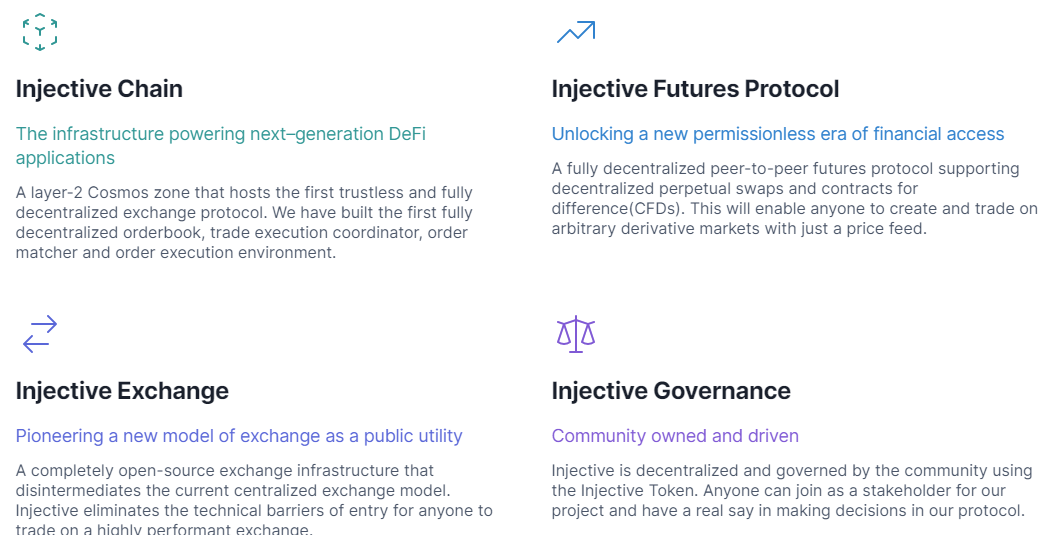What Is Injective Protocol?
The ability to crowdsource funds and launch hundreds of projects within a space with virtually no regulations has caused DeFi to become an oversaturated market in every respect. There are too many decentralized exchanges, lending protocols, and yield farming platforms. As such, the primary goal of every new DeFi project is to stand out by all means possible.
In the case of Injective Protocol, we have a project that targets the derivatives market with a decentralized and, before all, scalable approach. With heavy backing by industry giants like Binance, Pantera, and CMS, it is hard to ignore a team that boasts “limitless access to DeFi markets with zero barriers.”
What is Injective Protocol?
Injective Protocol is a decentralized derivatives exchange built on Ethereum and supported by a layer-2 solution that helps investors access DeFi markets in a swift and secure way.
Announced in April 2020, Injective Labs debuted its first project as the first fully decentralized exchange protocol in DeFi. The developer team’s very first goal was to surpass the limitations of the DEXs at that time, which limited users by relying on order book trading, high latency, poor liquidity, and other centralized designs.
When we talk about Injective Protocol, we are not only referring to a DEX that offers token swapping and yield farming. Rather than that, we are taking a look at a DEX that targets the derivatives market.
Injective Protocol is focused on bringing futures, margin, spot trading, and perpetual swaps to DeFi investors who are hungry for decentralization. According to Injective Labs, every component that supports the DEX is built in a censorship-resistant, public, and fully trustless way.
At its core, the project is made of three main components: Injective Chain, Injective Exchange, and the Injective Futures platform.
Injective Chain
Injective Labs describes the Injective Chain as a layer 2 sidechain that works hand in hand with Cosmos Zone. The chain represents the project’s infrastructure that powers next-gen DeFi applications in a fully trustless and decentralized manner.
The Injective Chain hosts features such as a decentralized order book, order matcher, order execution environment, and a trade execution coordinator.
By using a Cosmos-backed sidechain that supports EVM environments, the Injective chain makes it possible for the protocol to scale via L2 solutions despite offering its solutions on Ethereum.
Injective Exchange
As the name implies, Injective Exchange is a place where all the real magic happens. Rather than offering a centralized solution, which might as well be the industry’s gatekeepers, Injective Labs worked on transforming exchanges into decentralized platforms that have public utility.
On that account, the Injective Exchange and all of its data and tools are fully public. From front-end to back-end all of the features are open to the public and their potential scrutiny.
Just like many other DEXs, the business model of Injective Exchange relies on investors who act as liquidity providers who are rewarded for their contribution.
Injective Futures
Injective Futures is a peer-to-peer futures protocol that supports perpetual swaps, CFDs, and other derivative products in a decentralized manner. Anyone can create and trade on arbitrary derivatives markets with just a price feed.
All of the aforementioned features are under the management of Injective Governance, the project’s governance model. Therefore, all segments are owned and run by the community, which makes changes and votes for updates using the Injective token (INJ).
Why is decentralization so important?
In an industry built on the totems of decentralization, freedom, and privacy, it is strange to see how centralized exchanges have been the heart of crypto markets. Despite being centralized, and in some cases, run by teams with shady business practices, CEXs have reigned over crypto for more than a decade.
Apart from centralization, these exchanges have other disadvantages as well. Their coin custody measures are questionable, some platforms fall prey to identity breaches, there are often server downtime periods, cases of insider trading, and enormous fees that hurt small-sized traders.
To overcome these limitations, Injective Labs has worked on an exchange that places decentralization at the forefront of its mission. This means that users no longer have to provide KYC data, do not have to transfer custody of their assets to another platform, and do not have to pay insufferable fees.
At the start of the DEX era, most projects have not offered a fully decentralized solution. They were running on order books with no automated way of managing and processing trades. With the arrival of Injective Protocol and other newer projects that introduced automated market makers and decentralized order books, the situation has completely changed.
Last but not least, we also have to touch upon governance as an important factor supporting Injective’s decentralization. With the INJ token, investors have access to a voting model where they effectively act as shareholders. All features can be changed or removed by the community, and there is no central figure that can say no or edit smart contracts on its own.
INJ Tokenomics
Injective Protocol’s goal is to turn control and ownership over to its users, specifically those who own INJ tokens. INJ is an ERC20 token with a total supply of 100 million tokens and a market cap of $203 million.
The Injective token has a tentative initial supply of 100 million tokens which will increase for a set period of time along with block rewards. The supply is inflated in order to increase the sidechain’s security and incentivize nodes to stake INJ.
INJ’s inflation has a target rate of 7% since the first genesis block and is set to fall down to 2% over time. Due to its deflationary mechanism, the total supply of INJ may become lower than the initial supply.
In terms of governance, the token’s main utility, INJ can be used to govern components such as the futures protocol, protocol upgrades, and exchange parameters. For all governance proposals, investors must at least gather 1% of the token’s total supply for the proposal to enter a referendum period.
This period lasts for 14 days, during which INJ holders can support the proposal by voting. Voting power is proportional to the investor’s token balance. Once the period ends, the governance proposal can pass if a majority of the voting power approves the proposal and if a quorum threshold has been passed.
Final Word
Injective Protocol is an advanced decentralized exchange that offers features far beyond standard token swapping. The project is focused on derivatives trading, which is powered by decentralized order books that preserve a traditional exchange system while at the same time not sacrificing security or speed.
By functioning via a sidechain powered by the Cosmos SDK, Injective Protocol can offer scalable L2-fueled scalability on Ethereum. The project’s transactions are reportedly near-instant and charge incredibly low fees - especially in comparison to centralized exchanges.
Although Injective Protocol does not offer any crazy features that are enough for a majority of the community to switch over to their derivative markets, Injective Labs has done a great job at revolutionizing decentralization and scalability at a time where these issues were not at crypto’s forefront.
Will Injective Protocol progress far enough to gain a dominant position in the market, enough to attract both investors from DeFi and CeFi? Let us know what you think in the comments below!
Shrimpy is an account aggregating platform for cryptocurrency. It is designed for both professional and novice traders to come and learn about the growing crypto industry. Trade with ease, track your performance, and analyze the market. Shrimpy is the trusted platform for trading over $13B in digital assets.
Follow us on Twitter for updates!






